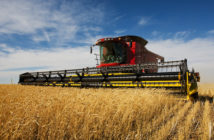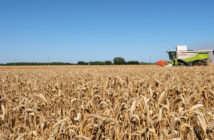Earlier today, AHDB published the January UK supply and demand estimates for wheat, barley, oats, and maize for the 2022/23 season. Here are some of the highlights for the wheat estimates.
In 2022/23, total cereals demand for animal feed is forecast at 12.789Mt, 61Kt lower than November’s estimate and down 335Kt on the year. This is the lowest level since 2016/17. Compared with previous estimates, animal feed production has declined at a greater rate than initially anticipated. Pig feed production is expected to continue fall back and so is poultry feed demand. Cattle feed demand declined last season and is forecast to remain slow in 2022/23. However, some regions have seen poor forage quality boosting feed requirements. Cereal inclusions in animal feed rations are also forecast to fall year-on-year, due to the relative price of protein meal. Human and industrial (H&I) total cereal usage is expected to increase by 219Kt year-on- year to 10.574Mt. This increase is largely driven by a rise in demand from bioethanol, starch and brewing, malting, distilling (BMD) industries
In 2022/23, total availability of wheat is estimated at 18.610Mt, down 124Kt from November’s forecasts, but 1.212Mt higher than in 2021/22. Following the release of the final results of the Defra Cereals and Oilseed Rape Production Survey, wheat production is estimated at 15.540Mt, 124Kt less than November’s AHDB estimate, but 1.552Mt higher year on year. Wheat imports remain unchanged from previous forecasts at 1.225Mt, down 769Kt from 2021/22 levels. The majority of imports are expected to be high protein wheat for milling, with a small proportion of feed wheat expected to go into Northern Ireland.
Human and industrial (H&I) wheat consumption is expected to be relatively unchanged (-9Kt) from November’s estimates, but increase by 264Kt year on year in 2022/23, to 7.376Mt. The increase on the year is largely driven by a rise in wheat usage by the bioethanol, starch and distilling industries. It is assumed both UK bioethanol plants will be in operation this season, but they are not expected to be running at full capacity, partly due to longer maintenance periods. Compared with November’s estimates, bioethanol usage is expected to be lower, but wheat usage in starch production and distilling is expected to rise this season, on the back of increased capacity. With high input costs and significantly lower bioethanol prices, bioethanol demand remains a key watch point this season. While flour production expected to remain relatively stable, wheat usage by millers is forecast to decline slightly on the year, driven by higher extraction rates on the back of higher specific weights. The impact of the ‘cost of living crisis’ on flour demand and some premium and alternative products, remains a key watchpoint. While the protein content of the 2022 crop has averaged lower, flour millers are expected to use a slightly higher amount of home-grown wheat this season as imports are not pricing as competitively. However, a proportion of imported high protein milling wheat will be required to ensure continuity in the grist.
Animal feed demand down
In 2022/23 usage of wheat in animal feed is 98Kt lower than November’s forecast and down 107Kt on the year at 7.141Mt. The decline from November’s estimates is largely driven by a greater fall in animal feed production to date, than initially anticipated. The proportion of wheat used in rations this season, compared with other cereals, is expected to increase, due to its availability and relative price. However, with a reduction in total cereal inclusions in rations and a fall in animal feed production, feed wheat usage is expected to fall on the year. The amount of wheat fed on farm is anticipated to be slightly lower this season due to its relative price, with growers yielding more by selling grain.
At 3.736Mt, the balance of total availability and domestic consumption is 17Kt lower than the previous estimate, but 1.048Mt or 39% higher than 2021/22 levels. The rise in total availability, driven mainly be a larger crop, has outweighed a slight rise in consumption, leading to the increased balance. With a significant balance, exports are currently forecasted at 1.150Mt for the season, up 639Kt from 2021/22. From July to November the UK exported 432Kt of wheat, which means to reach this forecast, a minimum of 100Kt per month needs to be shipped from December to June. Commercial end-season stocks are forecast at 2.586Mt for 2022/23, up 740Kt from 2021/22. A similar carry-out to 2019/20. Taking into account an operating stock requirement of 1.500Mt and exports to date (Jul-Nov) the UK has 1.804Mt of wheat available to be either exported from December to June or carried over into next season.




